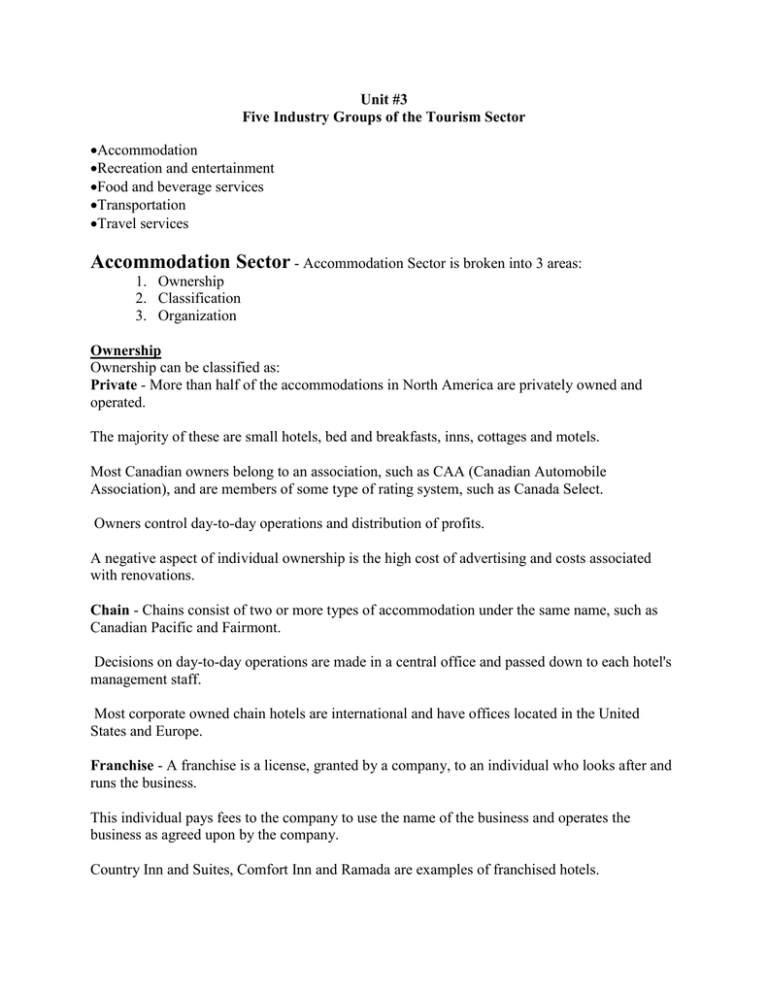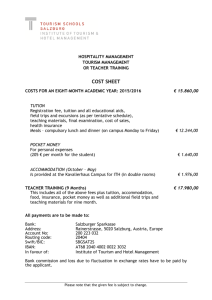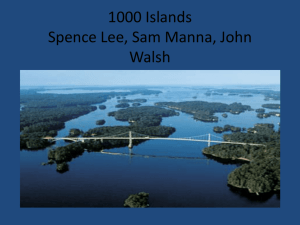hospitality_unit_4_notes
advertisement

Unit #3 Five Industry Groups of the Tourism Sector Accommodation Recreation and entertainment Food and beverage services Transportation Travel services Accommodation Sector - Accommodation Sector is broken into 3 areas: 1. Ownership 2. Classification 3. Organization Ownership Ownership can be classified as: Private - More than half of the accommodations in North America are privately owned and operated. The majority of these are small hotels, bed and breakfasts, inns, cottages and motels. Most Canadian owners belong to an association, such as CAA (Canadian Automobile Association), and are members of some type of rating system, such as Canada Select. Owners control day-to-day operations and distribution of profits. A negative aspect of individual ownership is the high cost of advertising and costs associated with renovations. Chain - Chains consist of two or more types of accommodation under the same name, such as Canadian Pacific and Fairmont. Decisions on day-to-day operations are made in a central office and passed down to each hotel's management staff. Most corporate owned chain hotels are international and have offices located in the United States and Europe. Franchise - A franchise is a license, granted by a company, to an individual who looks after and runs the business. This individual pays fees to the company to use the name of the business and operates the business as agreed upon by the company. Country Inn and Suites, Comfort Inn and Ramada are examples of franchised hotels. Management contract - Management contracts are an arrangement between the owner of the hotel and the operator. There is an agreement based on revenues from the business. Day-to-day operations are taken care of by the operator, and the owner receives the benefits. This type of ownership is often used in countries where local governments do not allow foreign companies to set-up and develop businesses. The operator, who is a citizen of the country, runs the business, and the owner is often a silent partner located in a different country. Classification A. Convention Hotels - These often cater to the needs and wants of a group and offer meeting rooms, areas to meet and greet people, food and beverage services and communication services, such as translation booths. They are usually located near the business centre of a city or town and can accommodate large groups, meetings and conferences. B. Campgrounds - Campgrounds can range from the basic tenting site to fully serviced sites for recreational vehicles. These can be privately owned, franchised or operated by the government. Campgrounds are located throughout Atlantic Canada, including in provincial and national parks. Prices vary depending upon location and services offered. C. Healthcare Accommodations - These types of accommodation include senior citizen homes, communities for retirees and assisted living accommodations. These are often located near hospitals and in urban centres. These can range from individual/independent apartment style accommodation to extra and full time support with meals and medical services provided on a 24 hour basis. D. Hostels: Youth and Elderhostels - Youth Hostels are accommodations such as those found at local YM and YWCAs, and newly converted from old hotels. They are generally open to people between 18 and 30 years of age. They offer various types of lodgings, from the simplest to luxurious or resort style of accommodation. They are reasonably priced and have full kitchen facilities, and clean sheets and towels are provided at check-in. Rooms can range from dorm style to private. People staying in a hostel share a common television area and bathrooms. Elderhostels are usually located in college dorms and are for people 60 years and older. E. Bed and Breakfast - These are also known as B&B’s. This type of accommodation is usually found in the owner’s home. This style of lodging had its origins in Europe and began when people needed to stay overnight in private homes. B&B’s and inns offer a unique setting with a nice room and full breakfast. Some inns and B&B’s are older style homes with antiques that give it a home-like atmosphere. Prices can range from $30 to $300, depending upon the location and facilities F. Full Service Hotels - These offer a full range of services similar to those in luxurious hotels. Examples include: multiple styles of restaurants and bars; health spas, including Jacuzzi and sauna rooms; gyms; weight rooms; tennis and squash courts and pool services. These hotels may even offer office services, such as in-room fax machines, computer drops and secretarial services. Prices would be equal to that of a downtown luxurious hotel. G. Resort Hotel - These were, in the past, popular lodgings for the richer travelers and were typically seasonal. With the development of air transportation, these accommodations began to operate year round. They are usually located in areas with beaches and spectacular scenery and offer specific activities, such as golf and swimming in the summer or skiing in the winter. These are often rated as mid to luxurious and most are all-inclusive. Some offer special activities to families and/or groups. H. Freeway Motels and Hotels - Built due to the rise in production of cars after WWII, these are often built near the edge of towns and are easily accessible by car as they are located close to the highways. These lodgings are reasonably priced and are also called the “mom-and-pop” motel. They offer more services, such as pools, phones and free colour TV’s. When these motels were first developed, they were small, offering approximately 20 units, but today have grown to include more than 100 units. I. Airport Hotels - These had their origins in the 1950’s and 1960’s and were built to accommodate the business class traveler and those travelling by air. They are located close to airports and have courtesy shuttles to and from the airport. These accommodations offer services 24 hours-a-day to meet the consumer’s needs. J. Downtown Hotel - These lodgings are located near the city centre. They feature services like valet parking or on-site free parking and can range from modest to luxurious. The downtown hotel often offers services such as full food and beverage services, meeting rooms, swimming pools and car rentals. K .Suite Hotels - These accommodations are often luxurious and offer more than one room. This can be an extra living room or a kitchenette. The extra room is usually offered at a higher price than a regular room at a typical hotel and is usually used for an extended stay. Organization The organization of a hotel depends on how many rooms it has and the services provided. There are two types of staff in every operation: A. Front of the house staff are those who have direct contact and meet and greet the guests face-to-face. B. Back of the house staff are those who are necessary to run the operation but usually do not work face-to-face with the guests. Recreation and Entertainment Sector - This sector includes outdoor activities, nature adventures and cultural adventures, attractions, entertainment and event management and coordination. Canada, due to its climate and changing seasons, is able to offer outdoor activities during all four seasons. Ski resorts, open for winter activities in the snowy and colder months, can host mountain bikers, hikers, golf and tennis enthusiasts during the summer months. There are 42 national parks in Canada and many provincial parks, where adventure tourism and recreation activities occur. Due to the vast coastline in the Atlantic Region and the easy access to rivers and lakes, water activities, including water skiing, boating, fishing, whale watching, kayaking and scuba diving are popular avenues for adventure tourism and recreation. Eco-tourism is an area of adventure tourism and recreation that is growing. This involves enjoying the outdoors while protecting the habitat from destruction and pollution. An attraction can be natural, such as our lakes, rivers, oceans and beaches, or man-made, such as historical sites, covered bridges, amusement parks, casinos and museums. Due to our climate, many of Canada's attractions are open from mid May until October; however, indoor attractions, such as casinos and theme parks, may operate year-round. Attractions can be based on our culture and heritage and/or built for pleasure, relaxation and recreation. Public museums, such as the New Brunswick Museum, are usually funded by the government and may contain artifacts, paintings, historical collections and specimens from the natural environment. Restored historic villages and forts are also included under this sector. Military reenactments and villages with people working the land in the traditional way show our cultural roots and past history (e.g. Kings Landing, Acadian Village and Fortress Louisbourg). One of Atlantic Canada's largest man-made attractions is the Confederation Bridge, which links New Brunswick and Prince Edward Island. Events and conferences are meeting and/or activities that use services from other sectors in the Hospitality and Tourism Industry, such as transportation, accommodations and food and beverage. For example, a person needs to travel to and from the event and/or conference. The event and/or conference often provide food and beverage services throughout and those staying overnight need some type of accommodation. Events and conferences can be further divided into the following four categories: Special Events- These are events that do not happen often (e.g. Olympics, 2004 Acadian celebrations, concerts, Papal visits, etc.). Annual Events- These are events that happen yearly (e.g. Saint John's "Festival by the Sea" and the Nova Scotia International Tattoo). Conferences, Meetings and Conventions- These events involve specific groups who gather to meet. These events may include annual general meetings and/or training and educational opportunities. Trade Shows - These are events where the industry can promote their products or services and/or make contacts with others in similar industry positions. These are usually held in arenas or trade and convention centres that can hold many people and booths for products (e.g. Moncton Kiwanis Lifestyle Show, Halifax International Boat Show and ApEx-Atlantic Canada's largest hospitality trade show). Food and Beverages Services Sector – Two Types: 1. Commercial: Commercial facilities focus exclusively on food and beverage services. Examples include cafeterias, take-outs, fine dining establishments, family restaurants, taverns and pubs. 2. Non-Commercial: Non-commercial facilities include accommodations, hospitals, movie theatres, and stadiums. These organizations' primary focus is on lodging, health care and entertainment, while providing food and beverage as an additional service. Commercial and non-commercial food and beverage services can be further divided into the following categories: Food and beverage in the accommodation sector Restaurants Entertainment/theme style establishments Catering services Clubs Roadside/transit services Institutional food and beverage services Other Transportation Sector – Modes of transportation include vehicles that travel by air, land and water. Air is the most popular way to travel; cars and motor coaches are the next most popular way to travel. Even if a traveler uses an airline to get to and from their destination, they will generally need to use some type of ground transportation, such as a taxi or shuttle service. Water transportation includes marinas and local charter services, but the most popular is the cruise industry. An advantage of a cruise over a hotel is the customer gets to visit multiple destinations. A cruise can be described as a full-service hotel on water. Travel Services Sector Travel services include tourism services and tourism trade sectors, which includes travel agencies, tour operators and tourism services. Tourism services encompass companies and organizations, including government services, that research, educate and promote products and/or services for the hospitality and tourism industry. Tourism services consist of government, industry associations, marketing companies and retail. The government is involved locally, provincially and at the federal level. Certain events are promoted locally by town chambers through tax dollars collected by the province and given to the municipalities. The municipalities, in turn, help to financially support the chamber. An example of provincial involvement is the 2004 Acadian celebrations. These celebrations are being promoted throughout the province of New Brunswick as well as in Nova Scotia and Maine. Each province has a tourism association that helps promote and educate persons involved in the hospitality and tourism industry. The Tourism Industry Association of New Brunswick is located in Fredericton and offers many educational opportunities to help those already in the industry and those who wish to become involved in the industry. On a federal level, the government helps to promote research and market Canada internationally (e.g. Canadian Tourism Commission and the Atlantic Canada Opportunities Agency. Marketing companies are also included if they specialize in the promotion of tourism services. Retail falls under this sector because stores and shops benefit from tourism dollars, which in turn, help to support the local economy. Travel services used to be referred to as the tourism services and tourism trade sectors. They may be broken into travel agencies and tour operators. Travel agencies are responsible for selling, reserving and booking packages, tours and airline tickets. There are more than 5,000 travel agencies in Canada. With more people booking online, travel agents must continue to be current with new technology to continue to be successful. Tours include packages with activities developed to sell to travel agencies. Although tour companies are independent, they do team-up with airlines and other agencies to better meet the needs of and provide services for potential markets.





